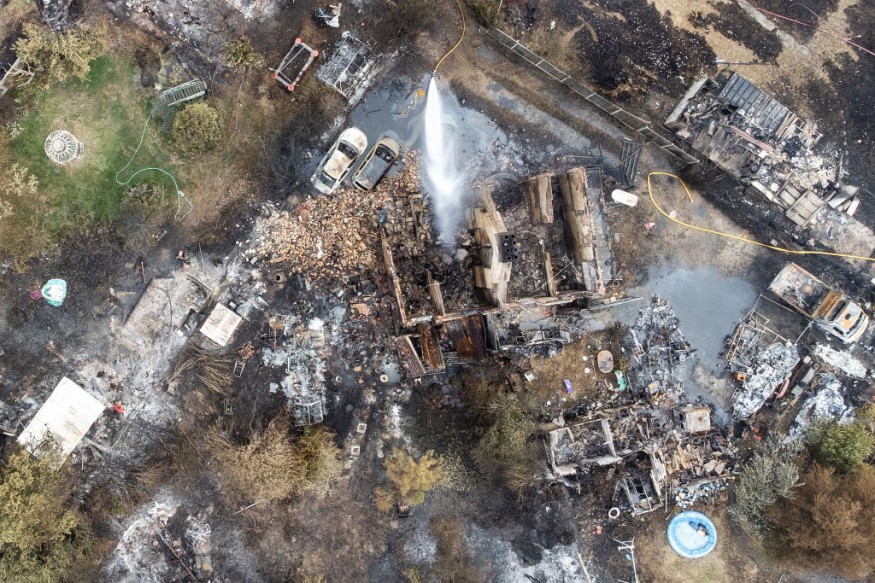One day after a historic and unprecedented heat wave brought temperatures to levels never seen in the country; cooler weather returned to the United Kingdom on Wednesday.

Scorching Temperatures
According to Mayor Sadiq Khan, the scorching weather caused transport delays and sparked several home and building fires around London, making it the London Fire Brigade's busiest day since World War II.
A tweet from Khan on Wednesday said that the green spaces in London are still dry and dangerous. Please do your part to lessen the strain on our emergency services and keep each other safe by refraining from having barbecues and exercising caution around smoke and glass.
The U.K. topped 40 degrees celsius on Tuesday at London's Heathrow Airport when the temperature was recorded at 104.4 F (40.2 C). Shortly after, farther north in the English town of Coningsby, the record high was surpassed when it reached 104.5 F (40.3 C), according to the U.K. The nation's official weather service is Met Office. The record was first established on Tuesday in the southern English community of Charlwood, where a temperature of 102.4 F was recorded (39.1 C).
Previous Records

The previous U.K. record for all time before Tuesday's heat was recorded three years ago, on July 25, 2019, when 102 F (38.7 C) was registered in Cambridge Botanic Garden. By Tuesday afternoon, the Met Office estimated that 34 observation stations had soared over the 2019 record.
Khan cited the severe heat as a "direct result" of the current global climate disaster.
He warned that unless we address the root causes of the problem, it will only worsen significantly.
On Monday and Tuesday, the London Ambulance Service reported receiving one emergency call every 13 seconds, with Tuesday seeing a "ten-fold increase in incidents related to heat exposure compared to last week, and an 8 percent increase in people fainting," according to the service, which reported receiving more than 13,000 emergency calls during the extreme heat on Wednesday.
Late last week, the U.K. Met Office issued amber severe heat warnings for a bigger region that included parts of Wales and Scotland, as well as the first-ever red extreme heat warning for portions of southern and central England. According to the nation's tier-based warning system, red is the highest degree of a weather alert.
This week, Britons rushed to the beaches and spent time splashing about in fountains, lakes, and rivers to stay cool in a nation where air conditioning is not widely available. Thousands of people hurried to the ocean to seek respite, swarming Brighton Beach on England's southeast coast.
Current Weather Status
Although Wednesday's weather was milder because of clouds and storms sweeping the nation, certain regions, including London, were still expected to see above-average temperatures. London's average high temperature in July was approximately 70 F (21 C), but Wednesday's prediction called for an 80 F high.
As the heat wave came to an end on Tuesday, Liz Bentley, chief executive of Britain's Royal Meteorological Society, said, "We get heat waves in the U.K. like other countries, but to see temperatures reach beyond 40 degrees Celsius, I never imagined I would see it here in the U.K. in my lifetime."
"Climate change undoubtedly has an imprint over this specific hot wave in western Europe," Bentley further stated.
The single runway at London's Luton Airport "melted," forcing officials to shut it down Monday, according to The Guardian, temporarily. In Oxfordshire, planes operated by the Royal Air Force were also grounded because of a bent runway.
Affected the Quality of Living
The U.K. Following multiple cancellations earlier in the week, locals were still coping with significant effects to rail service on Wednesday, according to The Associated Press. The central railway route between London and Edinburgh, commonly known as the Flying Scotsman, was shut down on Tuesday due to heat-related damage to electrical lines and signaling equipment, according to the London North Eastern Railway. To allow the necessary repairs, officials declared that the rail route would be shut down until at least Wednesday lunchtime.
U.K.'s air quality suffered as a result of the heat. According to AccuWeather meteorologists, the country was under high pressure, which confined pollutants in the lowest levels of the sky.
Related Article: Utah Faces an Environmental Catastrophe as the Great Salt Lake Continues to Dry Up
For more environmental news, don't forget to follow Nature World News!
© 2025 NatureWorldNews.com All rights reserved. Do not reproduce without permission.





